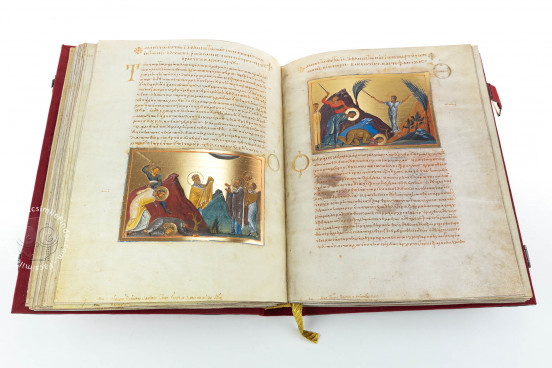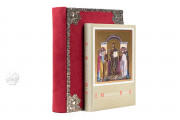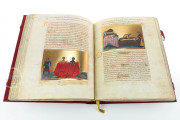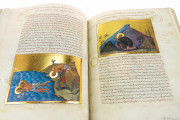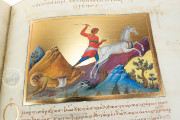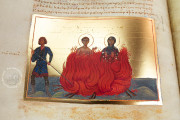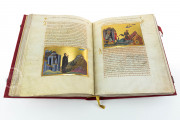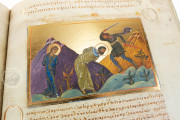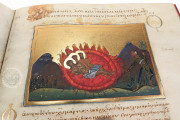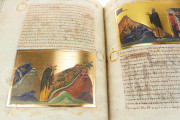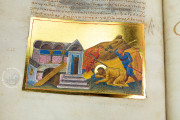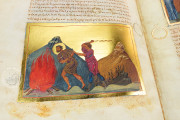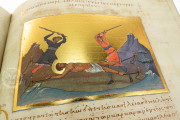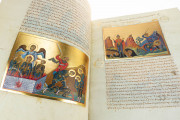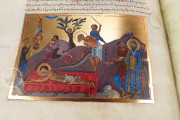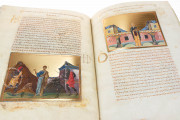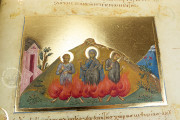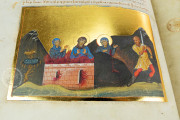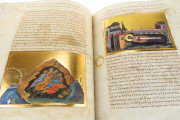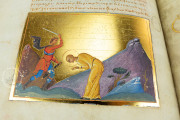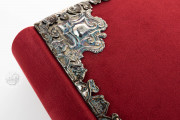Commissioned by Emperor Basil II (d. 1025) and passing through prestigious Italian collections during the early modern period, the Menologion of Basil II is celebrated as a gem of Byzantine manuscript painting. This masterpiece of courtly illumination pairs on each page sixteen lines in Greek commemorating a Christian saint with a half-page miniature rendered in vivid colors on backgrounds of gold leaf for a collection of 430 illuminations.
Rather than a true menologion (collection of saints' lives), the text is a version of the Constantinopolitan Synaxarion, a series of short remembrances to be read on saints' feast days. What survives today is only the first volume, containing the saints celebrated in the first six months of the Byzantine year, September through February.
The Work of Eight Illuminators?
One of the remarkable and mysterious features of this manuscript is that the scribe of the text consistently labeled each of these 430 miniatures with the name of one of eight painters. Fifteen of the miniatures lack their accompanying text, indicating that the illuminations were executed first.
The eight artists named are: Pantoleon, Michael of Blachernae, George, Symeon, Michael the Younger, Menas, Nestor, and Symeon of Blachernae. Theories abound as to the significance of these names, which could indicate the actual miniaturist, the painter first assigned to execute the miniature or the author of the original composition that served as inspiration.
Saints and Villains
The miniatures of the Menologion of Basil II depict an array of characters in a variety of positions. The prefatory poem states that these depictions were meant to be beneficial to the patron: "May he [the emperor] find as his assistants in his reign, all [saints] whom he pictured with colors, to be allies in his battles, deliverers from hardships, curers of illnesses, and in the Last Judgment fervent intercessors with the Lord."
The images celebrate martyrs, confessors, ascetics, and theologians. Gruesome images of persecution often incorporate malicious tormentors and executors. These villains are shown in vigorous motion in the wide ranges of stances needed to stone, spear, heave, and behead.
Dark-Skinned Converts
The Menologion is significant for its numerous depictions of people with dark skin, including the bare-armed spear-bearers wearing unusual tunics who approach Saint Thomas, believed to have established Christianity in India (p. 93). Their representation reveals the Byzantine perception of the appearance and clothing of the Byzantines' frequent partners in trade.
Nudes
Some miniatures include depictions of nude figures as sculpture that embellishes the sarcophagi—stone coffins—of saints or atop pedestals. These inclusions can appear at odds with the somber saints they accompany. For example, the regal Gregory the Great is flanked by two muscular nudes painted in grisaille—tones of gray—kneeling under the weight of decorative architectural cornices (p. 74).
Penned in Minuscule Resembling "Pearls on a String"
The Menologion of Basil II is an early example of the Perlschrift bookhand, which was prevalent beginning in the late tenth century. Perlschrift is a formal script with rounded (often circular) letter shapes. At its finest, such as in the present manuscript, it exhibits the harmonious proportions and spacing that give the effect of "pearls on a string."
A Gem of Princely and Ecclesiastical Italian Collections
An inscription in the manuscript identifies one of the manuscript's first Italian owners as Bartolomeo di Jacopo, a fourteenth-century lawyer and diplomat from Genoa who served as consul in Caffa (the modern-day port city of Feodosia on the Crimean Peninsula), suggesting that the book may have come to Italy via Crimea. Another inscription, however, states that the volume was sent directly from Constantinople to Ludovico Sforza (1452-1508), Duke of Milan. The duke gave the manuscript to Giovanni Battista Sfondrato, grandfather of Nicolò Sfondrati (1535 1591), who reigned as Pope Gregory XIV. The manuscript was officially inducted into the Vatican Library in 1615 when Pope Gregory's nephew gave it to Pope Paul V (1552-1621).
We have 1 facsimile edition of the manuscript "Menologion of Basil II": El Menologio de Basilio II facsimile edition, published by Testimonio Compañía Editorial, 2005
Request Info / Price
